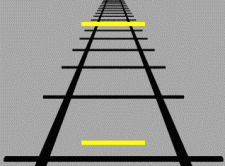Ponzo illusion
Ponzo Illusion is a visual illusion that was first demonstrated by the Italian psychologist Mario Ponzo in 1911. He suggested that the human mind judges an object's size based on its background. He showed this by drawing two identical lines across a pair of converging lines, similar to railway tracks. The upper line looks longer than the lower line, although they are both the same length. This illusion is an example of a perspective illusion.
Overview[edit | edit source]
The Ponzo Illusion capitalizes on the brain's system of judging depth and distance. In the classic illustration of this illusion, two horizontal lines of identical length are placed over a background of converging lines, such as a drawing of a road or railway tracks receding into the distance. The upper horizontal line appears longer than the lower one because our brain interprets the background cues as indicating that the upper line is farther away. Since both lines are actually the same size, our brain concludes that the line that appears farther away must be longer in order to maintain its size at that distance.
Mechanism[edit | edit source]
The underlying mechanism of the Ponzo Illusion involves the human perception system, which is influenced by linear perspective. Linear perspective is a depth cue that allows our brain to interpret the size of objects in the context of their perceived distance. When the converging lines suggest depth, objects placed in that context are perceived relative to that depth. This is why the Ponzo Illusion is often categorized under monocular cues, which are depth cues that can be perceived by one eye alone.
Applications and Significance[edit | edit source]
The Ponzo Illusion is more than just a curious visual trick; it has applications and significance in various fields such as psychology, neuroscience, and even design and art. In psychology and neuroscience, it helps researchers understand how the human brain processes visual information and how depth perception and size constancy work. In design and art, understanding this illusion can help artists and designers create more effective and engaging visual compositions by manipulating perspective to influence perception.
Related Illusions[edit | edit source]
The Ponzo Illusion is related to other visual illusions that involve perspective and depth cues, such as the Müller-Lyer Illusion, the Hering Illusion, and the Zöllner Illusion. Each of these illusions demonstrates different ways in which our perception of size, length, or direction can be distorted by contextual visual cues.
Conclusion[edit | edit source]
The Ponzo Illusion remains a fascinating topic in the study of visual perception, illustrating how our brains interpret visual information based on context and background cues. It underscores the complexity of the perceptual processes and the ways in which our environment can shape our perception of reality.
Navigation: Wellness - Encyclopedia - Health topics - Disease Index - Drugs - World Directory - Gray's Anatomy - Keto diet - Recipes
Search WikiMD
Ad.Tired of being Overweight? Try W8MD's physician weight loss program.
Semaglutide (Ozempic / Wegovy and Tirzepatide (Mounjaro) available.
Advertise on WikiMD
WikiMD is not a substitute for professional medical advice. See full disclaimer.
Credits:Most images are courtesy of Wikimedia commons, and templates Wikipedia, licensed under CC BY SA or similar.
Contributors: Prab R. Tumpati, MD

